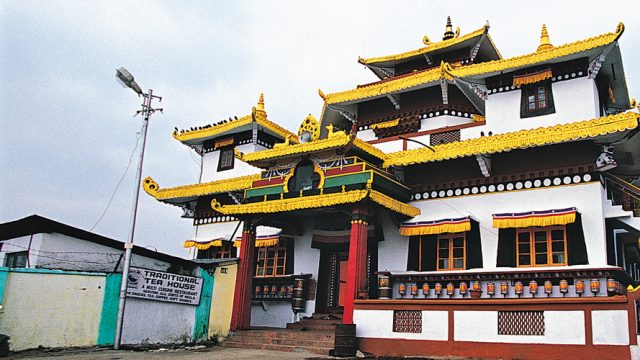Kalimpong is a relatively quiet Himalayan bazaar, rich in cultural and religious heritage. The town was once an important link along the trade routes linking Tibet with India through Sikkim. It was a part of the Sikkim Raja’s domain, until the Bhutan kings took over in the early 18th century. In 1865, after the Anglo-Bhutan War, Kalimpong was annexed to Darjeeling. Scottish missionaries came to the area in the late 19th century. As the tea estates grew in Darjeeling, a large number of labourers spilled over into neighbouring Kalimpong. Today it is one of West Bengal’s established school towns, a haven for retired people and a quiet hill resort. Recently, Kalimpong became the capital city of its own district.

Things to See & Do
Kalimpong still evokes strong memories of the Raj, evident in its colonial bungalows and old hotels. These include the lovely Morgan House, Crockety, Surya Sadan, Galingka, Tashi ding and Ringking Farm. En route to Deolo Hill is Dr Graham’s Homes, a campus spread across 500 acres.
St Theresa Church, built by local craftsmen to resemble a gompa, has wood carvings on the walls that depict biblical scenes, but the sculpted figures resemble Buddhist monks. From Sherpa Taar, you can see the gorgeous Teesta River drawing the boundary between West Bengal and Sikkim. The views are superb from both the Durga Mandir and the viewing gallery here. Near the Durga Mandir is Hanuman Park, with a 30-ft-high statue of Hanuman. Deolo Hill, at 5,413ft, is the highest point in Kalimpong and offers a fabulous pano ramic view of the entire hilly region.
Durpin Dara Hill is another vantage point (durpin means telescope in Nepali) from where you can take in views of the Teesta and Rangeet rivers below. On a clear day, you can see Khangchendzonga in all its splendour. The Army’s Lion’s Golf Course, the highest golf course in West Bengal, offers a grand view of the mountains. There is an Army post here from where you can get permission to play.
The Thongsha Gompa (open 6.00am–6.00pm), a Bhutanese Monastery, was established in 1692. Zong Dog Palri Fo-Brang Gompa (open 6.00am–6.00pm) was consecrated by the Dalai Lama in 1976. Built on the Durpin Dara Hill, it contains the Kagyur in 108 volumes, brought by the Dalai Lama when he fled Tibet. Established in 1992, the Tharpa Choeling Gompa belongs to the Dalai Lama’s Gelugpa (Yellow Hat) sect of Tibetan Buddhism. Dharmodaya Vihar is a residence for Buddhist monks, and has an excellent library on Buddhism.
Kalimpong’s flower nurseries have a lot to offer to floriculture enthusiasts. Pine View Nursery has the largest collection of exotic cacti in Asia. Universal Nursery has cactii, orchids, amaryllis and succulent flowers. Standard Nursery is appreciated for its roses, while Murgi Hatta is known for its brilliant gladioli.

Where to Stay
Kalimpong has accommodation available for all budgets. The Himalayan Hotel (Tel: 03552-255248, 258602) is one of the best hotels in. The Silver Oaks (Tel: 255296, 255767, Kolkata Tel: 033-40646300, 22269878, 22161033; Tariff: ₹7,900, with two meals) once belonged to a British family. Two WBTDC tourist bungalows are located in colonial-era buildings: Morgan House (Cell: 09733008776; Tariff: ₹2,100–3,500) and Tashiding Tourist Lodge (Tel: 283292, Cell: 09733008776; Tariff: ₹1,200–2,800). Holumba Haven Homestay (Tel: 255435; Tariff: ₹1,600–2,200, cottage ₹1,800–2,800), is a great option that offers home-cooked meals and water from a natural spring. Amongst budget hotels in Kalimpong, Cloud Nine (Cell: 09832039634; Tariff: ₹1,800–2,000) and Gompu’s Hotel (Cell: 09126000818; Tariff: ₹1,600–1,800) are good options.
Where to Eat
Kalimpong spoils you with steaming momo, thukpa, soup and chow stands at most street corners. Andre Butty, a Swiss Jesuit, set up the Swiss Welfare Dairy in Kalimpong and started a major cheese industry. You can still find some good cheese at Lark’s Provisions. Mandarin Restaurant is famous for its fish and roast pork. Kalsang on Link Road is a rustic place run by Tibetans

Around Kalimpong
Lava (34km)
Lava translates as ‘Heavenly Abode of the Gods’ in Bhutanese. It is a heavenly abode of mist-wrapped dhupi trees cradled by mountains.This gorgeous hill town is the stepping point into the beautiful Neora Valley National Park, which rises up to these hills from the Dooars below. Lava makes for a perfect base for trekking. The Kagyu Thekchen Ling Monastery, a training centre in Tibetan Buddhist theology for young monks, defines Lava’s skyline. The bright red building looms large over the little town, and offers a lovely view of the forests. The popular Changgey Falls, 2-hour-drive from Lava, is at its best in the months just after the monsoon rains. Tiffindara Viewpoint, at a height of 7,700ft, offers the best views of Khangchendzonga. You can also see parts of Sikkim, the Nathu La area and the Jelep La Pass from here.
Stay options here include WBFDC’s Lava Nature Resort (Kolkata Tel: 033-23350064/ 8320; Tariff: ₹900– 2,200), Hotel Greenland (Cell: 09163596075, 09874520005; Tariff:₹1,500–1,850), Yankee Resorts (Cell: 09932869205; Tariff:₹1,200–2,800) and Hotel Paradise (Cell: 09932889565; Tariff: ₹900–1,500).
Loleygaon (56km)
Loleygaon in the local dialect means ‘happy village’, and it is indeed a place where you can blissfully enjoy days spent lazing, interspersed with leisurely walks and admiring the views of the Khangchen dzonga Range. Head to Jhandi Dara for sunrise views. WBFDC’s Loleygaon Nature Edu cation and Wilderness Resort (Kolkata Tel: 033-23350064/ 8320; Tariff: ₹2,000–3,500), has cottages and lovely gardens.




